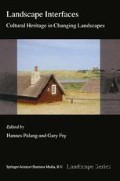Abstract
The area of eastern Poland, referred to as ‘the eastern wall’, is a rarity on a European scale. Unique landscapes have been preserved here, shaped in the past by the representatives of the nations, religions and cultures, which coexisted in this area. In this part of Poland — currently almost homogenous in terms of ethnical structure — elements that document stormy periods of historic development have been permanently inscribed in the landscape. In the present study, we perceive landscape as a historically shaped fragment of geographic space, which is the outcome of environmental and cultural interactions. The picture forms a specific structure, which manifests itself in the individual regional character of physiognomy. It is a synthesis of the natural environment and man’s activities. A natural environment comprises the whole of the natural conditions that provide a basis for man’s economic activity.
Access this chapter
Tax calculation will be finalised at checkout
Purchases are for personal use only
Preview
Unable to display preview. Download preview PDF.
References
Bartys, J. (1963). Lowland sheep-farming in the 2nd half of the I8th century and in the 1st half of the 19th century as exemplified by the Zamoyski Family Estate (pp. 13–30). Wroclaw: IHKM PAN, Ossolineum.
Baczkowski, K. (1999). History of late medieval Poland (1370–1506). Great History of Poland, 3, 12–15.
Buraczynski, J. (1977). Intensity of gully erosion and soil erosion in Goraj Roztocze. Zeszyty Probl Post. Nauk Rolniczych, 193, (pp. 91–99). Warsaw.
Buraczynski, J. (1997). Roztocze. Structure — relief- landscape. Lublin: ZGR UMCS.
Chalupczak, H., Browarek, T. (1998). National minorities in Poland 1918–1995 (pp. 55–92, 163–201). Lublin: UMCS Press.
Chlebowski, B. (1919). Zamosc. The Zamoyski Estate and the Zamosc district. Zamosc: Zygmunt Pomaranski & Co.
Eastern Roztocze. A tourist-topographical map 1:50,000. Raszyn: Wydawnictwo Oswiatowe ORTUS, Lubaczow: Wydawnictwo Naukowe, Turystyczne i Edukacyjne.
Fuks, M., Hoffman, Z., Horn, M., & Tomaszewski, J. (1982). Polish Jews. Warsaw: History and Culture.
Gurba, J. (1965). From the problems of early medieval settlement in the Lublin Upland. Annales UMCS (pp. 44–58). Lublin.
Gurba, J. (1985). An outline of the history of the Roztocze National Park. In T. Wilgat (Ed.), Roztocze National Park (pp. 7–9). Lublin: KAW.
Gorak, J. (1984). Former Orthodox churches in the Zamosc Voivodship. Zamosc: Biuro Badan i Dokumentacji Zabytkow w Zamosciu.
Gradziel, T., Janicki, G., & Skowronek, E. (2001). Transformations of the natural environment of the Guciow village in Central Roztocze under the influence of man’s activity. In K. German (Ed.) Transformations of the natural environment in Poland and its functioning. Problems of Landscape Ecology, 7, (pp. 294–300). Krakow: PAEK, GUJ.
Jagusiewicz, A. (1990). Ethnic values of Poland for Jewish tourism. Problems of Tourism, 3/4, (pp. 92–109). Lodz: Institute of Tourism.
Kutylowska, I. (1990) The development of Lublin in the 6th-14th centuries against the background of the urbanisation of the middle Vistula and Bug interfluve. Dissertation, (manuscript), UMCS, Lublin.
Libera, J. (1992). Late Paleolithic and Mesolithic periods in south-eastern Poland, Archaeological Letters, no. 2. Lublin.
Machnik, J. (1961). Archaeological research in Lublin Roztocze in 1959. Archaeological Reports, Vol. 12, Wroclaw-Warsaw-Krakow: Ossolineum.
Nosek, S. (1957). Materials for the study of ancient and early medieval history of the Vistula and Bug interfluve. Annales UMCS. Lublin.
Pawlowska-Wielgus, H. (1971). An inventory of cartographic materials of AOZ from Zwierzyniec. Management of AP. Lublin.
Statistical Year-book for the Zamosc Voivodship. 1984. Warsaw: GUS.
Statistical Year-book for the Zamosc Voivodship. 1990. Warsaw: GUS.
Statistical Year-book for the Zamosc Voivodship. 1996. Warsaw: GUS.
Town Index for the Polish Republic, 4. 1924. Lublin Voivodship, Warsaw: GUS.
Town index for the Polish Republic, 13. 1924. Lviv Voivodship, Warsaw: GUS.
Skowronek, E. (1996). Settlement development in the Lublin Upland and Roztocze, Geographic Magazine, LXVII, 2, 209–223.
Skowronek, E. (1999a). Anthropogenic transformations of the Roztocze landscape as exemplified by the Biala Lada and upper Wieprz drainage basins. Doctoral dissertation, manuscript, Biblioteka Glowna UMCS. Lublin.
Skowronek, E. (1999b). Changes in the landscape of the upper Wieprz drainage basin caused by man’s activity over the last millennium. Annales UMCS, B, Vol. 54, 14, 279–295.
Szafer, W. (1959). Land: Roztocze. Vol. 2. Vegetation cover in Poland (pp. 144–165). Warsaw: PWN.
Swieca, A. (1998). The influence of anthropogenic factors on the river runoff of solutions and suspensions in the Vistula and Bug interfluve. Lublin: UMCS Press.
Trzcinski, A. (not dated). Following the traces of the Jewish culture in the Lublin Region. Lublin: WOIT.
Turski, R., Uziak, S., & Zawadzki, S. (1993). Soils. Natural Environment of the Lublin Region (pp. 1–106). Lublin: Lublin Scientific Society Press.
Wartolowska, Z. (1958). Sutiejsk Czerwiensk stronghold in the Polish-Ruthenian borderland. Swiatowid, (Vol. 12). Selected data on the Lublin Voivodship. Statistical data. Lublin: GUS.
Wasowicz, T. (1961). Notes on the early medieval settlement in the Lublin Region. Archaeology of Poland, 6, 203–250.
Zoll-Adamikowa, H. (1974). Findings of preliminary research on the early-medieval settlement complex in Guciow in Zamosc district. Archaeological Reports, 26, 115–171.
Author information
Authors and Affiliations
Editor information
Editors and Affiliations
Rights and permissions
Copyright information
© 2003 Springer Science+Business Media Dordrecht
About this chapter
Cite this chapter
Skowronek, E., Krukowska, R., Swieca, A. (2003). Transformations of Cultural Landscape. In: Palang, H., Fry, G. (eds) Landscape Interfaces. Landscape series, vol 1. Springer, Dordrecht. https://doi.org/10.1007/978-94-017-0189-1_5
Download citation
DOI: https://doi.org/10.1007/978-94-017-0189-1_5
Publisher Name: Springer, Dordrecht
Print ISBN: 978-90-481-6348-9
Online ISBN: 978-94-017-0189-1
eBook Packages: Springer Book Archive

